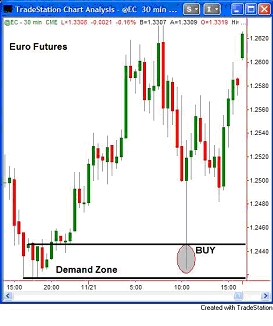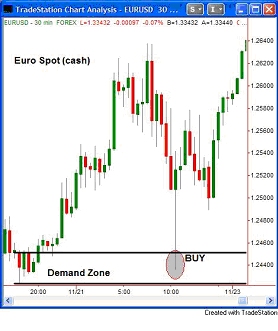Being the trader/trainer in the Extended Learning Track (XLT) Futures and Forex classes, I get this question all the time. Due to the ongoing evolution of these two markets, the answer is not as simple as you may think. In this piece, I will discuss what these markets are, identify the advantages and disadvantages of each of these two markets, and discuss how we deal with these markets in the XLT.
To begin with, both of these markets are where global currency values (exchange rates) are determined. These are fantastic markets as they are always moving and the moves and trends are larger than you will find in any other set of markets. The "spot" market is the cash market which means the current value (exchange rate) of where the currency pair is trading at right now. The "futures" market represents the perception of where that same currency pair will be trading at on a specific date in the future. For example, if you are trading the March 2009 Dollar / Yen, the price represents today's perceived value of the future (March 2009) exchange rate.


Here is a trade some traders in the XLT took not long ago in the Euro / Dollar. Both charts show the same opportunity on the same day in the same time frame. The only difference is that the chart on the left is the Euro Futures and the chart on the right is the Euro Spot. This was a buying opportunity on a pullback in price to a pre-determined demand zone. While the charts and this trading opportunity look almost identical, undertand that these two markets are very different. Before trading either of these markets, there are certain facts about these markets you must know. Let's first discuss the Spot market, and its pros and cons.
Cash (Spot) Forex
Forex Futures
Much more information on Forex Futures can be found on the CME website or by emailing me. The CME is: www.cmegroup.com.
Lots of game playing can go on in the Spot Forex market with certain brokers. Remember, they are market makers for the most part.
To begin with, both of these markets are where global currency values (exchange rates) are determined. These are fantastic markets as they are always moving and the moves and trends are larger than you will find in any other set of markets. The "spot" market is the cash market which means the current value (exchange rate) of where the currency pair is trading at right now. The "futures" market represents the perception of where that same currency pair will be trading at on a specific date in the future. For example, if you are trading the March 2009 Dollar / Yen, the price represents today's perceived value of the future (March 2009) exchange rate.


Here is a trade some traders in the XLT took not long ago in the Euro / Dollar. Both charts show the same opportunity on the same day in the same time frame. The only difference is that the chart on the left is the Euro Futures and the chart on the right is the Euro Spot. This was a buying opportunity on a pullback in price to a pre-determined demand zone. While the charts and this trading opportunity look almost identical, undertand that these two markets are very different. Before trading either of these markets, there are certain facts about these markets you must know. Let's first discuss the Spot market, and its pros and cons.
Cash (Spot) Forex
- No Central Exchange
This means that the market you're trading is the market your broker is making for you. This can lead to manipulation at times. There is a reason you hardly see volume in Spot Forex. It is because the real volume is very different than the "trillion dollar" volume you read about in all the marketing. The volume in this market is specific to the volume of order-flow from a specific broker, depending on how many accounts they have and the size of those accounts.
- Non - Regulated
Slowly but surely, the Spot Forex market is being regulated. It is still one of the least regulated markets around which really can lead to manipulation and risk. Most importantly, if you run into a problem with your account, you really have little to no recourse as there is no regulating body that 100% regulates the Forex markets as much as other markets.
- Broker Trades Against Client
Most but not all Forex brokers don't charge any commissions or fees. Instead, they get paid on the spread. What they do is constantly make a spread that ensures they will profit from your trades. When you push the button to buy or sell, they are on the other side of your trade. This means that your goals and their goals cannot be in alignment as you are trading against each other.
- Counterparty Risk
When you are trading a semi-non-regulated market, you have to make sure you know exactly where your account is actually being held. Is it being held at a large bank or some account that the broker has rights to? There have been some disaster stories such as Refco not long ago and others that come to mind. Make sure you know where your account is being held and how safe it is.
- No Commissions
You will see marketing for the spot Forex market that suggests "free trading"? If you believe that, I have some beautiful land in the desert for sale with a huge lake in the backyard and plenty of green grass, trust me? Anyway, most but not all Spot Forex brokers don't charge commission, they instead widen the spread in the real market, offer that artificially wide spread to you and get paid on the spread. Typically, a spread in a major pair might be 2-3 pips but can easily go as wide as 5-10 pips at times. At $10 a pip for most, this can mean that you are paying $20 - $30 to get into the trade. At that rate, commissions would be very cheap so don't be fooled when you see the "no commission" trading marketing material.
- Huge Leverage
In Spot Forex, 400:1 leverage is not uncommon. You can open an account with as little as $500 dollars and begin trading. That is not ideal but it can be done. Don't forget, leverage can work for you and against you, so be careful.
- Large Trends
The Forex market experiences large moves almost daily. There is always a currency pair trending strongly which means very frequent trading opportunity.
Forex Futures
- One Central Market (CME)
The Chicago Mercantile Exchange (CME) is the home of the Forex Futures. The CME is one of the largest exchanges in the world and is very well capitalized. Some of the largest Banks use the CME Forex Futures to hedge currency risk. I actually began my trading career on the Currency floor of the CME and understand the power of a central exchange.
- Transparent Volume
Because there is a central exchange, we can see trading volume and open interest easily.
- Very Regulated (SEC, NFA)
The CME actually has double regulation. They are a futures exchange so they are under the watchful eye of the NFA and the SEC. They are also a publicly traded company so they have another level of regulation that comes with that.
- Trades Matched on the Globex system
As with other Futures markets, the Forex Futures are traded in the trading pit but also on the Globex system. The Globex system is an order matching system much like NASDAQ for stocks. There is no broker on the other side of your trade. Instead, when you buy, your order is matched up with a seller like you, not a broker. This leads to a very fair and free market.
- Trading Times and Markets
While people are trading the Spot market at all hours of the day and night, this is not so in the Forex Futures. The higher volume time to trade is the US day session from early in the morning until about 2pm CST. Outside of those times, there is a substantial drop off in volume, especially overnight. Also, while the CME has most of the Forex pairs that the Spot market has available, at this time, there is not enough volume to trade any Forex pairs outside of the majors against the Dollar. For example, trading the Dollar / Pound futures during the day in the US is fine. Trading that market or almost any other during the US night session may not be a good idea as there is so little volume.
Much more information on Forex Futures can be found on the CME website or by emailing me. The CME is: www.cmegroup.com.
Lots of game playing can go on in the Spot Forex market with certain brokers. Remember, they are market makers for the most part.
Last edited by a moderator:
